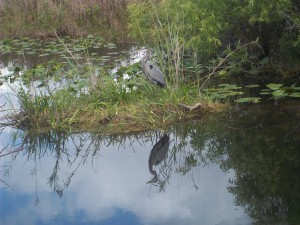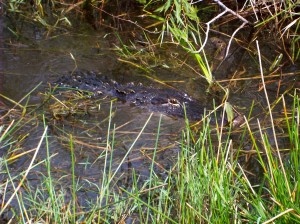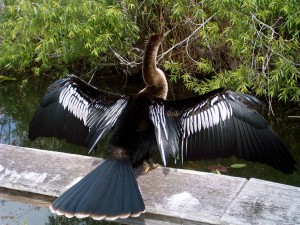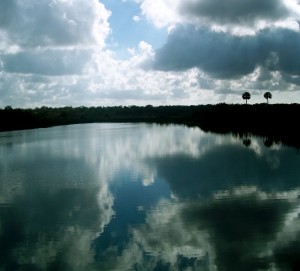Posted Sept. 23, 2012
By ELIZABETH DE ARMAS
FLORIDA CITY, Fla. – Emerald green grass, muddy black swamps, cyan skies and wildlife that encompass 1.5 million acres of the southern peninsula called South Florida. This is the Everglades.
Hot, muggy and full of mosquitoes – this is its downfall during the summer months. However, come November through May, you’re in for a treat.
Housing more than 14 federal endangered species, airboat tour rides, canoeing, kayaking and bird watching opportunities, the Everglades is a unique experience that allows for a variety of fun and exciting adventure.
Most Everglades first-timers are probably wondering how to see over a million acres of land in a one time visit to Florida City, Tamiami Trail or Everglades City. The truth is, it isn’t possible. But, don’t panic.
With about eight to 10 hours, a few bottles of water and some snacks, the trip will exceed all expectations.
Where to Visit
The Ernest Coe Visitor Center would be the ideal place to start a first-time excursion through the national park. Take Florida’s Turnpike South until it ends and the center can’t be missed, unless you don’t follow the signs. The Coe Visitor Center offers brochures of the wildlife that visitors will encounter, educational displays, maps of the park, a gift shop and plenty of insect repellant.
After a quick stop at the Coe Visitor Center, hop in the car and get comfortable because it’s a 38-mile drive to Flamingo Visitor Center – your next stop. The center is near Florida City, south of the Miami metro area. Here, visitors can rent canoes, bicycles, kayaks and houseboats. Also, airboat tour registration is available and it is close to several hiking trails.
Think of the Flamingo Visitor Center as the gateway to the Everglades, and a place to get some air conditioning before being immersed into Mother Nature.
An airboat tour ride is a must do while at the park. Here, not only do visitors get to experience a guided tour through the murky waters, but also it is the perfect opportunity to be close to the infamous alligators and few crocodiles that are seen from time to time. Let’s not forget the beautiful birds such as the whooping crane, great blue heron and vulture.
Oh, for those very lucky visitors who come in the winter: That is when the endangered Florida Panther is seen patrolling the park most. However, it is extremely rare to catch a glimpse.
Cameras should be in hand for this smooth boat ride.
“Many enjoy the hiking, kayaking, and other opportunities to get outdoors in a beautiful wilderness just miles from the hustle and bustle of an area with nearly 7-million people,” Everglades Public Information Officer Linda Friar said.
Another captivating adventure is the Anhinga Trail, a quarter mile boardwalk that allows visitors to take in the serene atmosphere of this historical landmark. The trail is located in the homestead entrance of the park, along with other trails such as the Mahogany Hammock and the Pahayokee Overlook.
“Winter in the Everglades is a great time to bird watch,” Friar said. “By January, a walk on he Anhinga Trail can provide a visitor the opportunity to view over 30 different types of birds in a short and enjoyable walk.”
As November approaches in South Florida, many migratory birds traveling to the Caribbean and other southern points pit stop in the Everglades for some time. This is one of the main reasons, besides cooler temperatures, that winter is the time for visitors to get the full-out Everglades experience.
A bonus to add to those trails: Knowledgeable park rangers guide visitors through these walks and point out the wildlife by name. They even stop for pictures.
On a time crunch? Don’t forget to squeeze Shark Valley in to your schedule, a 49-mile drive from the Flamingo Visitor Center.
While the airboat tours take visitors through a trail of the park’s infamous “River of Grass,” the Shark Valley tram tour is a two-hour guided bus tour that takes visitors through the Northern region of the park.
But the best part of Shark Valley is the Observatory Tower. Visitors walk up a ramp, which can be a little tiring, but the view is absolutely breathtaking. When individuals are at the top of the tower looking down, they’re seeing the heart of the Everglades.
For Jonathan Penichet, a 22-year-old Miami native, the Observatory Tower is his “favorite spot.”
“I remember traveling to the Everglades for the first time and wondering what I would encounter,” Penichet said. “I loved the wildlife, the trails and the beauty of the park, but the tower was captivating… almost magical really. You’re standing at the top of a platform looking down and thinking, ‘Wow. This is really something.’ Truly, I have no words for it.”
Points on the Park
The Everglades was established Dec. 6, 1947, and is the third-largest national park in the lower 48 states of the U.S. It is also the largest stand of saw grass prairie in North America and the largest remaining subtropical reserve in the nation.
If that doesn’t get visitors enticed, the Everglades is not just a park. It is a breeding sanctuary, a Biosphere Reserve, a Wetland and a home. It holds South Florida’s history.
“Before the era of fancy homes, Knaus Berry Farm, Florida City Outlet Mall, night life in Miami and touristy hotels on the beach strip, South Florida was the Everglades,” 34-year-old Miami native Jennifer Leal said. “You don’t know Florida until you’ve seen the Everglades. It’s like staring at your ancestors.”
The Everglades not only habitats wildlife, but there are many plants and trees that cannot be seen in other parts of the Sunshine State found at the park. From towering trees to barely noticeable shrugs, these plants provide food, shelter and breeze for its occupants and visitors alike.
Friar said Marjory Stoneman Douglas, an American journalist and environmentalist, summed up why tourists should visit the Everglades on the first page of her novel, The Everglades: A River of Grass, published in 1947:
There are no other Everglades in the world. They are, they have always been, one of the unique regions of the Earth, remote, never wholly known. Nothing anywhere else is like them; their vast glittering openness, wider than the enormous visible round of the horizon, the racing free saltness and sweetness of their massive winds, under the dazzling blue heights of space. They are unique also in the simplicity, the diversity, the related harmony of the forms of life they enclose. The miracle of the light pours over the green and brown expanse of saw grass and of water, shining and slow-moving below, the grass and water that is the meaning and the central fact of the Everglades of Florida. It is a river of grass.
IF YOU GO
- For more information on directions, tours, rentals and history of the Everglades, visit http://nps.gov/ever/. For additional feature stories about the Everglades and Everglades National Park, visit http://ournationalparks.us/index.php/site/landing_everglades.
- Do not get close to the wildlife. They are in their natural environment and not trained.
- Pack water, snacks, and insect repellant.
- There is a lunch area with benches where you can eat, but you must throw away trash.
- Bring a camera and an extra battery.
- The park entrance fee is $10 for private vehicles.
Ernest Coe Visitor Center phone number, address, and hours of operation:
- 305-242-7700
- 40001 State Road 9336, Homestead, Fla. 33034
- 9 a.m. – 5 p.m.
Flamingo Visitor Center phone number, address, and hours of operation:
- 239-695-2945
- 1 Flamingo Lodge Highway, Homestead, Fla. 33030
- 9 a.m. – 4:30 p.m.
Shark Valley Visitor Center phone number, address, and hours of operation:
- 305-221-8776
- 36000 SW 8th St., Miami, Fla. 33194
- 9 a.m. – 5 p.m.




